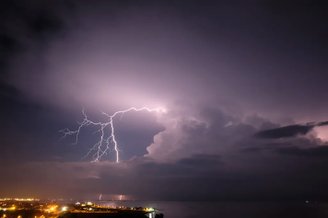Tropical storms produce two different types of strong radiation: terrestrial gamma-ray flares (TGFs) and gamma-ray flares. Although both involve the acceleration of electrons to speeds close to the speed of light, TGFs are faster and more energetic, while the radiations are less intense and longer-lived.
Recently, an international research team using NASA aircraft discovered a third type of gamma-ray emission, called the “missing link.” The duration of this irradiation is shorter than steady irradiations and longer than TGFs, and has been named by researchers as oscillatory gamma-ray flash (FGF).
The discovery of this third pathway provides new insights into the mechanisms that produce lightning, as well as Scientists’ understanding of the radiation emitted by storm clouds. The practical result of this is; The development of more accurate estimates of electrical storm risk to humans, aircraft and spacecraft.
How does gamma radiation occur during thunderstorms?
The process by which gamma radiation occurs during storms is well known to scientists. When storms begin, the internal dynamics become extremely energetic due to the intense movement of air, water and ice particles; these rise and fall, causing the process of separation of electrical charges.
In this way, positive charges concentrate at the top of the storm, while negative charges move downward, creating an incredibly intense electric field. This very high-energy environment causes charged particles, primarily electrons, to accelerate, causing a chain reaction when they collide with air molecules.
In other words, each collision releases more electrons and the process becomes stronger to the point of creating conditions for complex nuclear reactions such as: those that occur only in particle accelerators or nuclear reactors. This includes kinetic energy, which can ionize atoms, separate protons and neutrons from atomic nuclei, and produce high-energy particles such as gamma rays, antimatter, and other forms of radiation.
Investigating gamma ray storms
Co-author of the current study, professor Steve Cummer from Duke University in the US, explains in a statement: “Some aircraft campaigns have tried to find out whether these events are common, but there have been mixed results and many campaigns over the US have not found gamma radiation.”

To clarify the mystery, the authors used NASA’s high-altitude airborne scientific aircraft, the ER-2, which was actually a retrofitted U2 spy plane. This Cold War-era plane can fly at twice the altitude of commercial airliners. less than three miles above most storms. His speed allowed him to select more promising storms for research.
After a month of flying, the spy plane flew over ten major tropical storms in southern Florida and managed to detect gamma radiation in nine of them. According to co-author Martino Marisaldi of the University of Bergen in Norway, the image of gamma-bright thunderstorms “resembles a large, boiling gamma-bright pot in both pattern and behavior.”
What is your assessment of lightning research?

For Marisaldi, it was a great surprise that lightning strikes, which are “almost impossible to detect in space”, were completely visible at an altitude of 20 kilometers. At least 25 new flashes lasting 50 to 200 milliseconds were detected; This is a record in the understanding of high-energy atmospheric events.
Additionally, the author, physicist Joseph Dwyer from the University of New Hampshire in the USA, emphasized the importance of these discoveries for understanding how storms work. The abundance of quick bursts and medium-duration flashes “tells us something about how thunderstorms work, which is really important because thunderstorms produce lightning that injures and kills a lot of people.”
Another surprise was that using old aircraft instead of satellites turned out to be very effective, overcoming the limitations. Proof that the research exceeded all expectations was the identification of more than 100 flares, according to NASA scientist Timothy Lang.
The findings were recently described in two papers published in Nature.
Stay up to date on the latest physics studies at TecMundo. If you wish, take the opportunity to explore the NASA mission that examined the most powerful gamma ray burst in the Universe.
Source: Tec Mundo
I’m Blaine Morgan, an experienced journalist and writer with over 8 years of experience in the tech industry. My expertise lies in writing about technology news and trends, covering everything from cutting-edge gadgets to emerging software developments. I’ve written for several leading publications including Gadget Onus where I am an author.












